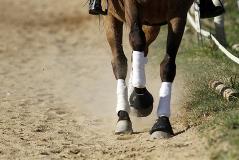Lameness: Helping Clients Understand the Diagnosis Process

Equine lameness is commonly identified with abnormalities of the stance or gait as a result of disorders of the musculoskeletal system.
Diagnosing Lameness
Lameness is a clinical indication of a problem that can be challenging to identify even with a thorough understanding of equine anatomy and conformation. A veterinary examination is essential for gathering the information that will lead to the diagnosis of the cause. Clients who understand the reasons for the different evaluation components may recognize the need to be more communicative when providing information and assistance.
Causes of Lameness
Most commonly originating from the manifestation of pain, clients should be informed that lameness can also result from conditions of mechanical restrictions and neuromuscular diseases that occur with:
- Trauma
- Infection
- Congenital disorders
- Metabolic disorders
- Acquired disorders
- Nervous system diseases
- Circulatory system diseases
The basic information necessary to diagnose the cause of lameness and establish a treatment plan will include its history, a standing examination, and a moving examination.
History of Horse
Explain to clients that the purpose of the medical history is to identify and provide basic information that will help diagnose the problem and establish a timeline of medical change.
Necessary information will consist of:
- Age
- Use of horse
- Conditioning
- Vaccination history
- Medical history
- Preexisting conditions
- Lameness history of horse
- Day and situation when lameness was first observed
Standing Examination
Explain to clients that the standing examination provides a general physical examination when the horse is at rest, and will focus on the information gathered earlier on the history of the animal.
- If client is the handler, instruct on the necessity of the horse remaining still.
- This part of the examination may consist of:
- Hands-on check of muscles and joints for heat, swelling, pain, reduced range-of-motion, lesions
- Injuries or stress
- Palpating tendons and ligaments
- Assessment of blood flow to the feet
- Hooves checked for:
- Rocks, cracks, embedded foreign objects
- Uneven hoof or shoe wear
- Loose shoes or nails placed in a sensitive part of the hoof
- Hoof tester to determine:
- Bruised sole
- Sore heels
- Foundered hoof
- Hoof abscess
- Navicular lameness
- Conformation Assessment
- Balance and symmetry
- Weight bearing ability
- Mouth check
- Pain from teeth can cause a horse to act and move differently causing strain.
- Look for indications of old scars, splints that may/may not relate to lameness.
Moving Examination
Explain to clients that the information gathered will help to establish a baseline, and the way the horse is worked will depend upon the level of its physical ability.
- If the client is the handler it is important that they understand their role in the examination
- Describe how they will need to walk or trot the horse at an even rate and in a straight line for a specified distance.
- Explain that they will need to keep the horse on a loose lead line in order to allow its head to move freely as this may help to identify the problem.
- Veterinarians should clarify that without these elements it will be difficult to visualize the need of the horse.
- This part of the examination evaluates how the horse moves, and may consist of:
- Walking and/or trotting in a straight line
- Working on a lunge line
- Movement under saddle
- Utilizing a foundation of dry ground or sand.
Treatment and Prognosis
The treatment for lameness varies dependent upon the horse and the level of its lameness. Various types of therapies involve:
- Conservative therapy: stall rest or hand walking
- Surgery: removal of bone fracture chips or to repair fractures of bones with plates or screws
- Nonsteroidal anti-inflammatory drugs
- Joint injection with anti-arthritic compounds
- Physical therapy
- Extracorporeal shock wave therapy (ESWT)
- Interleukin-1 receptor antagonist protein (IRAP)
- Stem cell therapy
Clients need to be made aware that when diagnosed early and cared for appropriately, most lameness conditions will resolve. However, the longer it takes to begin treatment, the more difficult the condition will be to heal. They also need to realize that the outcome of the treatment and prognosis will vary depending on the horse and the type of lameness.
Need more information on managing lameness to assist your clients? Contact your Covetrus representative today at 855.724.3461.
Need Regulatory Assistance
If you need help with regulatory or licensing issues, we're happy to help. We have a wide variety of resources to help you when issues arise.

Careers
Are you looking for a place to let your talents shine? At Covetrus, we help our practitioner customers better serve their patients and take pride in providing the best customer experience possible. Search our open positions to see our available opportunities.
Newsletter
Stay current with what’s going on with Covetrus, subscribe to receive our newsletter and email communications. Subscribers will receive the latest information in practice management, sales and marketing, animal health, and more.


Leave a comment